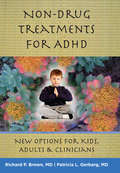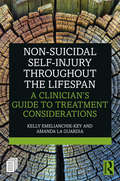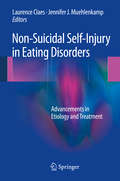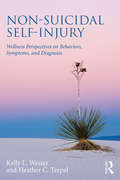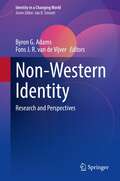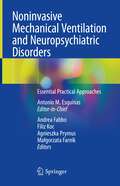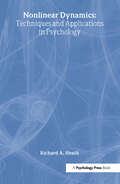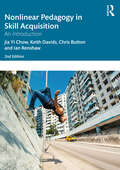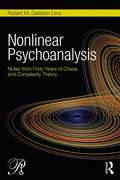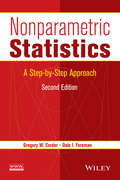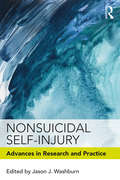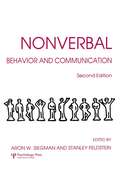- Table View
- List View
Non-Democratic Legitimacy During the Arab Spring: Defending Dictatorship
by Nicolai Due-GundersenThis book analyzes non-democratic legitimacy during the Arab Spring. During this historic event, monarchs and presidents were forced to defend their rule, whether through Islam, the cultural image of paternalism or the cash flow of welfare. Can Arab leaders still justify apolitical reigns? Are monarchies more respected than republicans or are they too under threat? The author traces the history of apolitical rule in the Arab world, from Islamic roots to the role of Arab leaders in merging religion with socio-economic benefits and cosmetic liberalization. Finally, analysis of speeches given by leaders of Tunisia, Egypt, Jordan and Bahrain in response to the Arab Spring are considered. When protesters took to the streets with their slogans, the regimes talked back. This work discusses the weight of their words and why some leaders survived unrest while others were overthrown.
Non-Drug Treatments for ADHD: New Options for Kids, Adults, and Clinicians
by Patricia L. Gerbarg Richard P. BrownSafe and effective complementary treatments for managing ADD/ADHD. The prolific use of drugs to treat ADHD stirs heated debate in therapy and parenting circles today. Is this medication really going to improve my son's symptoms? How best can I help my patient and her parents manage this difficult disorder? Will the side effects of this drug outweigh the benefits? What are my other options? Because ADHD affects every facet of life, from psychosocial development and peer relationships to family dynamics and academic and job performance, the need for better--that is, safer and more effective--treatments is urgent. Here, seasoned clinicians Pat Gerbarg and Richard Brown, known for providing the latest breakthroughs in integrative mental health treatments, draw on over 30 years' clinical experience to offer a range of scientifically-grounded complementary and alternative treatments for parents and professionals alike. Studies show that children with untreated ADHD are at greater risk for substance abuse, unemployment, accidents, and criminal behavior, in addition to learning disabilities, anxiety disorders, social phobia, depression, and bipolar disorder. And yet, individuals with ADHD often bring a great deal of energy, enthusiasm, and creativity to the tasks they undertake. Gerbarg and Brown focus on these intrinsic strengths, encouraging parents and professionals to help children with ADHD fulfill their potential by overcoming distraction, restlessness, and impulsivity in order to focus on learning, task completion, and understanding social cues. To accomplish this, they argue, we need to implement a variety of alternative approaches. Drawing on stories and anecdotes from their own clinical practice, Gerbarg and Brown address the questions that are particularly important to those dealing with ADHD. Early chapters provide information about diagnostic issues and the scientific foundation for understanding the known causes of ADHD, as well as how different treatments may work and why. Multiple contributing causes of ADHD exist--genetic, nutritional, chemical, psychological, trauma-based, and environmental--and the authors explain how treatments need to be strategically combined and tailored to patients' unique needs and sensitivities. Later chapters present integrative strategies that combine the best practices of psychological treatments with herbs, nutrients, cognitive enhancers, mind-body practices, and brain stimulation. Throughout, the authors draw on the work and methods of many talented clinicians, yoga therapists, and teachers who have found creative, effective approaches to helping their own clients who struggle with attentional problems. A comprehensive resources section at the end of the book features a compilation of need-to-know websites, journals, books, and supplement brands with dosing recommendations. Psychiatrists, psychologists, and other therapists are equipped with access to the very latest research in both conventional and complementary and alternative approaches. With this book, the authors of How to Use Herbs, Nutrients & Yoga in Mental Health have taken their extraordinary scholarly and healing talents to a new level, helping parents and therapists alike to better understand and manage a complicated and multifaceted disorder.
Non-Emerging Adulthood: Helping Parents of Adult Children with Entrenched Dependence
by Haim Omer Dan DulbergerThis book offers a therapeutic approach to a problem that many families and mental health institutions face: a growing number of adult children who struggle to progress to a psychological, social adulthood. The family patterns that revolve around adult children can remain inert for decades, are often resistant to conventional therapy, and can cause chronic suffering to adult children, parents, and extended families. The authors present a guide that addresses parents of adult children as suffering people in their own right and as essential to assisting their child into entering functional adulthood. The authors, one of whom is the originator of the Non-Violent Resistance Therapy approach (NVR), provide an intervention manual that implements NVR principles for helping families of adult children. The book is based on the authors' ten-year journey of helping such families in cases where traditional interventions and therapeutic values seem not to work.
Non-Suicidal Self-Injury Throughout the Lifespan: A Clinician's Guide to Treatment Considerations
by Kelly Emelianchik-Key Amanda La GuardiaA comprehensive guide for clinicians working with patients engaging in self-injury, this book provides information on clinical conceptualization, risk and protective factors, ways to assess for NSSI, treatment approaches and strategies, and early intervention and prevention strategies. Focusing on ethical and cultural considerations unique to schools, clinical agencies, and private-practice settings, the authors provide a practical and in-depth discussion of clinical theory. Procedures for determining risk and the potential problems with risk assessment, especially concerning suicide risk, are addressed. In addition to numerous exercises, examples, and suggestions for practical interventions, the book includes a variety of detailed worksheets and resources to expand readers’ level of understanding, monitor emerging trends, and provide a context for extended training. Several case studies are discussed and analyzed in order to highlight specific aspects of clinical conceptualization and treatment strategies. Drawn from a wide range of treatment populations and issues, this book is a valuable resource for clinicians and supervisors. The authors integrate outcomes-based research strategies and evidenced-based tools to help clinicians work with clients from diverse backgrounds.
Non-Suicidal Self-Injury in Eating Disorders
by Laurence Claes Jennifer J. MuehlenkampNon-suicidal self-injury and eating disorders represent significant problems among today's youth and pose unique challenges for clinicians, particularly when they co-occur. This book is a rare resource in that it provides cutting-edge information on the interactions between self-injury and disordered eating, empirically informed treatments for the co-occurrence of these behaviors, and specific topics relevant to understanding nuances in the risk factors, treatment, and prevention of both self-injury and eating disorders. Practitioners, graduate students, and researchers working within this specialized area will find this text to be instrumental in advancing their knowledge and improving the treatment of self-injury in those with eating disorders.
Non-Suicidal Self-Injury: Wellness Perspectives on Behaviors, Symptoms, and Diagnosis
by Kelly L. Wester Heather C. TrepalGrounded in a wellness, strengths-based, and developmental perspective, Non-Suicidal Self-Injury is the ideal guide for counselors and other clinicians seeking to understand self-injurious behaviors without pathologizing them. The book covers topics not previously discussed in other works, including working with families, supervising counselors working with clients who self-injure, DSM-5 criteria regarding the NSSI diagnosis, NSSI as a protective factor for preventing suicidal behavior, and advocacy efforts around NSSI. In each chapter clinicians will also find concrete tools, including questions to ask, psychoeducational handouts for clients and their families, treatment handouts or treatment plans for counselors, and more. Non-Suicidal Self-Injury also includes real-life voices of individuals who self-injure as well as case vignettes to provide examples of how theoretical models or treatments discussed in this book immediately apply to practice.
Non-Toxic Masculinity: Recovering Healthy Male Sexuality
by Zachary WagnerDismissals such as "boys will be boys" and "not all men" are ingrained in our world. And the purity culture of our youth sold the same excuses with a spiritual spin. Can we break the toxic cycle and recover a healthy identity for men? In Non-Toxic Masculinity, Zachary Wagner tells men, "If you are in Christ, this is your problem—and you should be part of the solution." Reflecting on his own coming of age in the purity culture movement and ongoing recovery from sexual shame, Wagner confronts harmful teaching from the American church that has distorted desire, sex, relationships, and responsibility. For those—both men and women—who feel disillusioned and adrift, this book offers a renewed vision for Christian male sexuality founded in empathy and selflessness.
Non-Violent Resistance: A New Approach to Violent and Self-Destructive Children
by Haim OmerNon-violent resistance (NVR) is an approach for parents and other caregivers that helps to increase presence and overcome impulsive and dangerous behaviors, while reducing conflict and escalation. The practical, evidence-based advice accompanies a detailed list of all the new applications of NVR and an overview of the supporting literature. A step-by-step presentation of the treatment is laid out alongside a useful model on escalation and its prevention. The approach achieves high parent engagement and cooperation, with over twenty controlled studies showing that NVR effectively reduces parental helplessness, parental impulsiveness, parent–child conflicts, and family discord.
Non-Western Identity: Research and Perspectives (Identity in a Changing World)
by Byron G. Adams Fons J. R. van de VijverIdentity is a construct strongly rooted and still predominantly studied in Western (or WEIRD; Western, educated, industrialized, rich, and democratic) contexts (e.g., North American and Western European). Only recently has there been more of a conscious effort to study identity in non-Western (or non-WEIRD) contexts. This edited volume investigates identity from primarily a non-Western perspective by studying non-Western contexts and non-Western, minority, or immigrant groups living in Western contexts. The contributions (a) examine different aspects of identity (e.g., personal identity, social identity, online identity) as either independent or interrelated constructs; (b) consider the associations of these constructs with aspects of intergroup relations, acculturative processes, and/or psychological well-being; (c) document the advancement in research on identity in underrepresented groups, contexts, and regions such as Africa, Asia, Eastern Europe, the Middle East, and South America; and (d) evaluate different approaches to the study of identity and the implications thereof. This book is intended for cultural or cross-cultural academics, practitioners, educators, social workers, postgraduate students, undergraduate students, and scholars interested in studying identity. It provides insight into how identity in non-Western groups and contexts may both be informed by and may inform Western theoretical perspectives.
Non-consensual Image-based Sexual Offending: Bridging Legal and Psychological Perspectives (Palgrave Studies in Cyberpsychology)
by Craig A. Harper Dean FidoThis book presents a timely analysis of the psychological influences, underpinnings, and predictors of non-consensual image-based sexual offending (NCIBSO), such as revenge pornography, cyber-flashing, deepfake media production and upskirting. In this rapidly expanding field, this book offers a novel perspective that encompasses both a forensic psychoanalytic analysis of offending behaviours and an examination of the influence of our use of online environments and digital platforms on these behaviours. The authors begin by outlining the historical and legal context before moving on to a critique of previously posited motivating factors. Rather than conceptualising NCIBSO in purely gendered terms, they demonstrate the potential for a psychological framework to facilitate a better understanding of how and why people engage in a range of non-consensual sexual image offences. In doing so it will provide fresh insights for policymakers and clinicians, in addition to scholars from across the fields of psychology, sociology, criminology, law, media and gender studies.
Non-violent Communication and Narrative Medicine for Promoting Sustainable Health (New Paradigms in Healthcare)
by Maria Giulia MariniThe Covid-19 pandemic and current international circumstances have left many individuals feeling vulnerable, both economically and psychologically. At the same time, pressure is put on healthcare systems, particularly in Europe, resulting in doctor shortages, heavy workloads, and low salaries for healthcare workers. Patients are experiencing longer waiting lists, shorter visiting times, and emergency rooms that underestimate patients' clinical problems. As a result, episodes of self-violence and violence resulting from different causes are happening more frequently, also in hospitals. However, there is hope, and it starts with sharing our needs, thoughts, and feelings. This is where narrative medicine comes into play, as it helps bring stories to light, listen, ask open questions, analyze the spoken words, metaphors, and timing of communication, and promote a non-violent narrative. The key is to transition from violent to non-violent narratives and the consideration of relationship as a fundamental part of the therapeutic process, deserving an in-depth educational program. This is even more true if one considers that the ecosystem of health, together with the inclusion of diversity and the promotion of peace, is one of the main pillars of the UN Sustainable Development Goals.This book aims to inspire care for one another through the narratives of people with disabilities, patients, nurses, doctors, students, carers, and individuals who meet otherness and resolve conflicts.
None of This Rocks: A Memoir
by Joe TrohmanLead guitarist and cofounder of Fall Out Boy shares personal stories from his youth and his experiences of modern rock and roll stardom in this memoir filled with wit and wisdom. Trohman cofounded Fall Out Boy with Pete Wentz in the early aughts, and he&’s been the sticky element of the metaphorical glue-like substance holding the band together ever since, over the course of a couple decades that have included massive success, occasional backlashes, and one infamous four-year hiatus. Trohman was, and remains, the emotive communicator of the group: the one who made sure they practiced, who copied and distributed the flyers, and who took the wheel throughout many of the early tours. As soon as he was old enough to drive, that is—because he was all of 15 years old when they started out. That&’s part of the story Trohman tells in this memoir, which provides an indispensable inside perspective on the history of Fall Out Boy for their legions of fans. But Trohman has a great deal more to convey, thanks to his storytelling chops, his unmistakable voice, and his unmitigated sense of humor in the face of the tragic and the absurd. None of This Rocks chronicles a turbulent life that has informed Trohman&’s music and his worldview. His mother suffered from mental illness and multiple brain tumors that eventually killed her. His father struggled with that tragedy, but was ultimately a supportive force in Trohman&’s life who fostered his thirst for knowledge. Trohman faced antisemitism in small-town Ohio, and he witnessed all levels of misogyny, racism, and violence amid the straight edge hardcore punk scene in Chicago. Then came Fall Out Boy. From the guitarist&’s very first glimpses of their popular ascension, to working with his heroes like Anthrax&’s Scott Ian, to writing for television with comedian Brian Posehn, Trohman takes readers backstage, into the studio, and onto his couch. He shares his struggles with depression and substance abuse in a brutally honest and personal tone that readers will appreciate. Not much of this rocks, perhaps, but it all adds up to a fascinating music memoir unlike any you&’ve ever read.
Noninvasive Mechanical Ventilation and Neuropsychiatric Disorders: Essential Practical Approaches
by Antonio M. Esquinas Andrea Fabbo Filiz Koc Agnieszka Prymus Małgorzata FarnikIn different sections of this book the relationships between the patterns of psychological response in acute and chronic respiratory failure, as well as the epidemiology of neuropsychiatric disorders in ventilator management, are collected and analyzed. Main concepts such as “vulnerability to stress”, critical illness-psychological stress and susceptibility that may develop during NIV support, as well as the diagnosis of neuropsychiatric disorders in respiratory failure are also summarized. A section is devoted to the most frequent indications of NIV, also including a special use of NIV in pandemic and high-risk infections, as well as in several other conditions such as acute and chronic respiratory failures and neurological disorders. A summary of practical approaches for treatment and prevention in neurologic and psychiatric disorders during noninvasive mechanical ventilation, as well as the perspective in terms of outcomes, quality-of-life, palliative care is also given.The book is intended for all those healthcare professionals treating patients suffering from neurological or psychiatric disorders and who develop acute or chronic respiratory failure. Neurologists, psychiatrists, pulmonary critical care professionals, geriatricians, internists and psychologists will find in the book a valuable guide for their everyday clinical practice.
Nonlinear Contingency Analysis: Going Beyond Cognition and Behavior in Clinical Practice
by R. Trent Codd, III T. V. Layng Paul Thomas Andronis Awab Abdel-JalilNonlinear Contingency Analysis is a guide to treating clinically complex behavior problems such as delusions and hallucinations. It’s also a framework for treating behavior problems, one that explores solutions based on the creation of new or alternative consequential contingencies rather than the elimination or deceleration of old or problematic thoughts, feelings, or behaviors. Chapters present strategies, analytical tools, and interventions that clinicians can use in session to think about clients’ problems using decision theory, experimental analysis of behavior, and clinical research and practice. By treating thoughts and emotions not as causes of behavior but as indicators of the environmental conditions that are responsible for them, patients can use that knowledge to make changes that not only result in changes in behavior, but in the thoughts and feelings themselves.
Nonlinear Dynamics: Techniques and Applications in Psychology
by Richard A. HeathAdditional Resource Materials Human behavior would not be interesting to us if it remained the same from one moment to the next. Moreover, we tend to be sensitive to changes in people's behavior, especially when such change impacts on our own, and other's, behavior. This book describes a variety of techniques for investigating change in behavior. It employs conventional time series methods, as well as recently developed methodology using nonlinear dynamics, including chaos, a term that is not easy to define, nor to confirm. Although nonlinear methods are being used more frequently in psychology, a comprehensive coverage of methods, theory and applications, with a particular focus on human behavior, is needed. Between these covers, the reader is led through various procedures for linear and nonlinear time series analysis, including some novel procedures that allow subtle temporal aspects of human cognition to be detected. Analyses of reaction times, heart-rate, psychomotor skill, decision making, and EEG are supplemented by a contemporary review of recent dynamical research in developmental psychology, psychopathology, and human cognitive processes. A consideration of nonlinear dynamics assists our understanding of deep issues such as: Why is our short-term memory capacity limited? Why do chronic disorders, and also cognitive development, progress through stage-like transitions? Why do people make irrational decisions? This book will be of particular interest to researchers, practitioners, and advanced students in a variety of areas in psychology, particularly in human experimental and physiological psychology. Data analyses are performed using the latest nonlinear dynamics computer packages. A comprehensive WWW resource of software and supplementary information is provided to assist the reader's understanding of the novel, and potentially revolutionary, procedures described in the book.
Nonlinear Pedagogy in Skill Acquisition: An Introduction
by Ian Renshaw Keith Davids Jia Yi Chow Chris ButtonNonlinear Pedagogy is a powerful paradigm for understanding human movement and for designing effective teaching, coaching and training programmes in sport, exercise and physical education (PE). It addresses the inherent complexity in learning movement skills, viewing the learner, the learning environment and the teacher or coach as a complex interacting system. The constraints of individual practice tasks provide the platform for functional movement behaviours to emerge during practice and performance. The second edition includes new materials, of practical, theoretical and empirical relevance, to enhance understanding of how to implement a Nonlinear Pedagogy to support learning in sport, PE and physical activity. There is updated, in-depth discussion on the various pedagogical principles that support Nonlinear Pedagogy and how these principles are applicable in learning designs in sports and physical education. There is further emphasis on examining how transfer of learning is implicated in practice, highlighting its relevance on skill adaptation and talent development. The first part of the book updates the general theoretical framework to explain processes of skill acquisition and motor learning. This edition draws clearer links between skill acquisition, expertise and talent development, focusing on how specificity and generality of transfer have a role to play in the development of learners. The book defines Nonlinear Pedagogy and outlines its key principles of practice. It offers a thorough and critical appraisal of the functional use of instructional constraints and practice design. It discusses methods for creating challenging and supportive individualised learning environments at developmental, sub-elite and elite levels of performance. The second part focuses on the application of Nonlinear Pedagogy in sports and PE. There is a greater emphasis on helping applied scientists and practitioners understand the impact of Nonlinear Pedagogy on transfer of learning. Every chapter is updated to provide relevant contemporary cases and examples from sport and exercise contexts, providing guidance on practice activities and lessons. Nonlinear Pedagogy in Skill Acquisition is an essential companion for any degree-level course in skill acquisition, motor learning, sport science, sport pedagogy, sports coaching practice, or pedagogy or curriculum design in physical education.
Nonlinear Pedagogy in Skill Acquisition: An Introduction
by Ian Renshaw Keith Davids Jia Yi Chow Chris ButtonNonlinear pedagogy is a powerful paradigm for understanding human movement and for designing effective teaching, coaching and training programs in sport, exercise and physical education. It addresses the inherent complexity in the learning of movement skills, viewing the learner, the learning environment and the teacher or coach as a complex interacting system, with the constraints of individual practice tasks providing the platform for functional movement behaviours to emerge. This is the first book to explain this profoundly important new approach to skill acquisition, introducing key theoretical ideas and best practice for students, teachers and coaches. The first section of the book offers a general theoretical framework to explain processes of skill acquisition and the learning of movement skills. The book then defines nonlinear pedagogy, and outlines its key principles of practice. It offers a thorough and critical appraisal of the optimal use of instructional constraints and practice design, and discusses methods for creating challenging and supportive individualised learning environments at developmental, sub-elite and elite levels of performance. Every chapter contains cases and examples from sport and exercise contexts, providing guidance on practice activities and lessons. Nonlinear Pedagogy in Skill Acquisition is an essential companion for any degree level course in skill acquisition, motor learning, sport science, sport pedagogy, sports coaching practice, or pedagogy or curriculum design in physical education.
Nonlinear Psychoanalysis: Notes from Forty Years of Chaos and Complexity Theory
by Robert M. Galatzer-LevyNonlinear concepts from chaos theory, complexity studies, and fractal geometry have transformed the way we think about the mind. Nonlinear Psychoanalysis shows how nonlinear dynamics can be integrated with psychoanalytic thinking to shed new light on psychological development, therapeutic processes, and fundamental psychoanalytic concepts. Starting with a personal history of the author’s engagement with nonlinear dynamics and psychoanalysis, this book describes how his approach applies to diagnosis of psychological conditions, concepts of normal and pathological development, gender, research methods, and finally the theory and practice of psychoanalysis and psychodynamic psychotherapy. This book is full of new ideas about the basic nonlinear processes of human development, nonlinear views of gender and fundamental psychoanalytic process like working through, and the nature of the therapeutic process as conceptualized in terms of the theory of coupled oscillators. Galatzer-Levy questions many standard psychoanalytic formulations and points to a freer practice of psychoanalysis and psychoanalytic thinking. His new approach opens the reader’s eyes to ways in which development and treatment can occur through processes not now included in standard psychoanalytic theory. The book not only provides useful theories but also helps readers take note of commonly passed over phenomena that were unseen for lack of a theory to explain them. Galatzer-Levy brings an unusual combination of training in psychiatry, psychoanalysis, and mathematics to this unique study, which summarizes his forty years of exploration of nonlinearity and psychoanalysis. Nonlinear Psychoanalysis will appeal to psychoanalysts and psychotherapists as well as students of nonlinear dynamics systems.
Nonlinear Psychophysical Dynamics
by Robert A.M. GregsonNonlinear Psychophysical Dynamics utilizes new results in systems theory as a foundation for representing sensory channels as a form of recursive loop processes. It demonstrates that a range of phenomena, previously treated as diverse or anomalous, are more readily seen as related and as the natural consequence of self-regulation and nonlinearity. Some cases with appropriate data analysis are reviewed.
Nonparametric Statistics
by Dale I. Foreman Gregory W. Corder"...a very useful resource for courses in nonparametric statistics in which the emphasis is on applications rather than on theory. It also deserves a place in libraries of all institutions where introductory statistics courses are taught." -CHOICEThis Second Edition presents a practical and understandable approach that enhances and expands the statistical toolset for readers. This book includes:New coverage of the sign test and the Kolmogorov-Smirnov two-sample test in an effort to offer a logical and natural progression to statistical powerSPSS® (Version 21) software and updated screen captures to demonstrate how to perform and recognize the steps in the various proceduresData sets and odd-numbered solutions provided in an appendix, and tables of critical valuesSupplementary material to aid in reader comprehension, which includes: narrated videos and screen animations with step-by-step instructions on how to follow the tests using SPSS; online decision trees to help users determine the needed type of statistical test; and additional solutions not found within the book.
Nonrational Logic in Contemporary Society: A Depth Psychology Perspective on Magical Thinking, Conspiracy Theories and Folk Devils Among Us
by Jim KlineNonrational Logic in Contemporary Society explores modern examples of beliefs that defy logic but nevertheless are enthusiastically embraced by legions of contemporary people living in technologically advanced societies. The appeal of nonrational logic is based upon C.G. Jung’s ideas regarding archetypes, considered to be unconscious thought and behavioural patterns universal to all of humanity and expressed in dreams, art, religion, and reports of supernatural and paranormal experiences such as the belief in UFOs, conspiracy theories associated with child sacrifice and devil worship, lizard people who secretly rule the world, and internet demons whom many insist are real. C.G. Jung insisted that archetypal reality must be acknowledged for what it is: expressions of universal truths about the human condition. Nonrational Logic includes a multitude of examples from world folklore and reports of traditional customs from around the world collected in the multivolume anthropological classic, The Golden Bough, by James Frazer, comparing these traditional reports with contemporary ones to underscore the human psyche’s obsessive desire to embrace the fantastic, the extraordinary, and the unbelievable. Nonrational Logic in Contemporary Society is important reading for analytical psychologists, Jungian psychotherapists, and other professionals seeking to understand how prevalent nonrational thinking is in modern societies and how it reflects traditional expressions.
Nonsense and Meaning in Ancient Greek Comedy
by Stephen E. KiddThis book examines the concept of 'nonsense' in ancient Greek thought and uses it to explore the comedies of the fifth and fourth centuries BCE. If 'nonsense' (phluaria, lēros) is a type of language felt to be unworthy of interpretation, it can help to define certain aspects of comedy that have proved difficult to grasp. Not least is the recurrent perception that although the comic genre can be meaningful (i. e. contain political opinions, moral sentiments and aesthetic tastes), some of it is just 'foolery' or 'fun'. But what exactly is this 'foolery', this part of comedy which allegedly lies beyond the scope of serious interpretation? The answer is to be found in the concept of 'nonsense': by examining the ways in which comedy does not mean, the genre's relationship to serious meaning (whether it be political, aesthetic, or moral) can be viewed in a clearer light.
Nonsense: The Power of Not Knowing
by Jamie HolmesAn illuminating look at the surprising upside of ambiguity--and how, properly harnessed, it can inspire learning, creativity, even empathy Life today feels more overwhelming and chaotic than ever. Whether it's a confounding work problem or a faltering relationship or an unclear medical diagnosis, we face constant uncertainty. And we're continually bombarded with information, much of it contradictory. Managing ambiguity--in our jobs, our relationships, and daily lives--is quickly becoming an essential skill. Yet most of us don't know where to begin. As Jamie Holmes shows in Nonsense, being confused is unpleasant, so we tend to shutter our minds as we grasp for meaning and stability, especially in stressful circumstances. We're hard-wired to resolve contradictions quickly and extinguish anomalies. This can be useful, of course. When a tiger is chasing you, you can't be indecisive. But as Nonsense reveals, our need for closure has its own dangers. It makes us stick to our first answer, which is not always the best, and it makes us search for meaning in the wrong places. When we latch onto fast and easy truths, we lose a vital opportunity to learn something new, solve a hard problem, or see the world from another perspective. In other words, confusion--that uncomfortable mental place--has a hidden upside. We just need to know how to use it. This lively and original book points the way. Over the last few years, new insights from social psychology and cognitive science have deepened our understanding of the role of ambiguity in our lives and Holmes brings this research together for the first time, showing how we can use uncertainty to our advantage. Filled with illuminating stories--from spy games and doomsday cults to Absolut Vodka's ad campaign and the creation of Mad Libs--Nonsense promises to transform the way we conduct business, educate our children, and make decisions. In an increasingly unpredictable, complex world, it turns out that what matters most isn't IQ, willpower, or confidence in what we know. It's how we deal with what we don't understand.From the Hardcover edition.
Nonsuicidal Self-Injury: Advances in Research and Practice
by Jason J. WashburnNonsuicidal Self-Injury moves beyond the basics to tackle the clinical and conceptual complexity of NSSI, with an emphasis on recent advances in both science and practice. Directed towards clinicians, researchers, and others wishing to advance their understanding of NSSI, this volume reviews and synthesizes recent empirical findings that clarify NSSI as a theoretical and clinical condition, as well as the latest efforts to assess, treat, and prevent NSSI. With expertly written chapters by leaders in the field, this is an essential guide to a disorder about which much is still to be known.
Nonverbal Behavior and Communication
by Aron W. Siegman Stanley FeldsteinFirst published in 1987. Routledge is an imprint of Taylor & Francis, an informa company.

